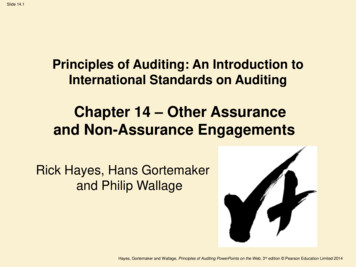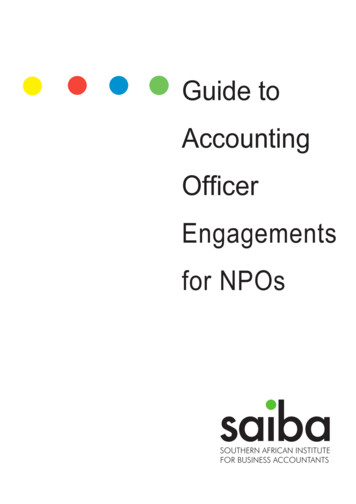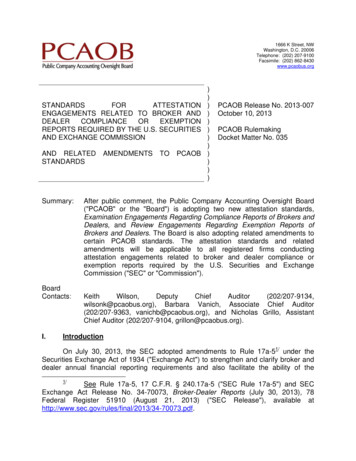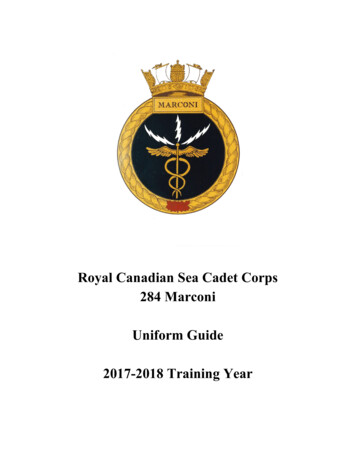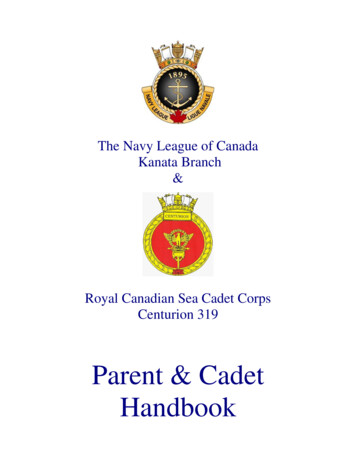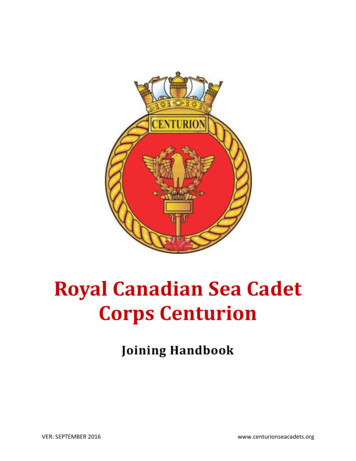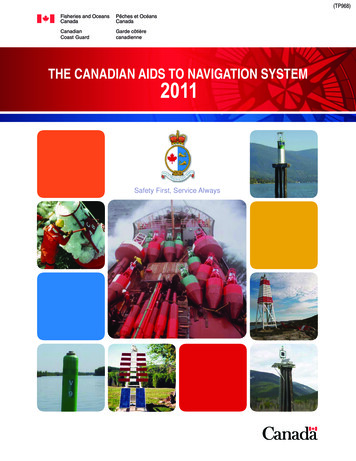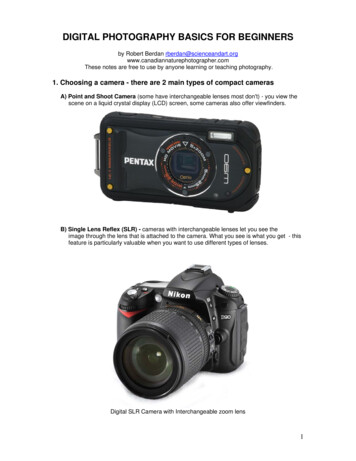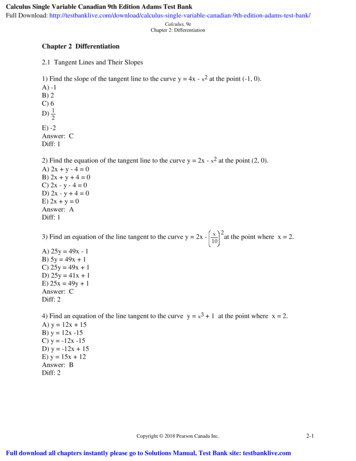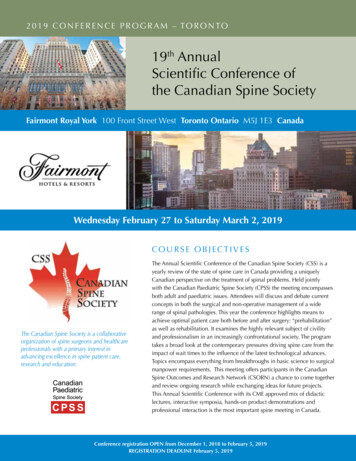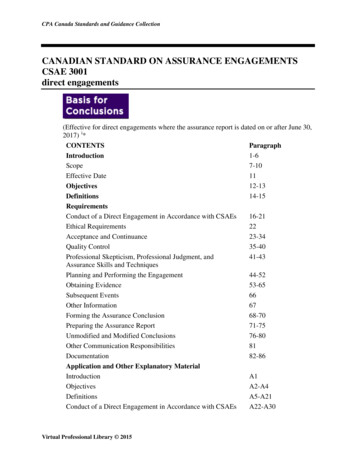
Transcription
CPA Canada Standards and Guidance CollectionCANADIAN STANDARD ON ASSURANCE ENGAGEMENTSCSAE 3001direct engagements(Effective for direct engagements where the assurance report is dated on or after June 30,2017) ve onduct of a Direct Engagement in Accordance with CSAEs16-21Ethical Requirements22Acceptance and Continuance23-34Quality Control35-40Professional Skepticism, Professional Judgment, and41-43Assurance Skills and TechniquesPlanning and Performing the Engagement44-52Obtaining Evidence53-65Subsequent Events66Other Information67Forming the Assurance Conclusion68-70Preparing the Assurance Report71-75Unmodified and Modified Conclusions76-80Other Communication Responsibilities81Documentation82-86Application and Other Explanatory -A21Conduct of a Direct Engagement in Accordance with CSAEsA22-A30Virtual Professional Library 2015
CPA Canada Standards and Guidance CollectionCONTENTSEthical RequirementsAcceptance and ContinuanceQuality ControlProfessional Skepticism and Professional JudgmentPlanning and Performing the EngagementObtaining EvidenceSubsequent EventsOther InformationDescription of the Applicable CriteriaForming the Assurance ConclusionPreparing the Assurance ReportUnmodified and Modified ConclusionsOther Communication ResponsibilitiesDocumentationAppendix 1: Roles and ResponsibilitiesAppendix 2: Illustrations of Differences between AttestationEngagements and Direct -A185A186-A189A190A191-A198Introduction1.This Canadian Standard on Assurance Engagements (CSAE) deals with directengagements. A direct engagement is an assurance engagement in which the practitionerevaluates the underlying subject matter against applicable criteria and aims to obtainsufficient appropriate evidence to express, in a written direct assurance report, aconclusion to intended users other than the responsible party, about the outcome of thatevaluation. (Ref: Para. A22-A23)2.CSAE 3000 ii1 deals with attestation engagements other than audits or reviews ofhistorical financial information, which are dealt with in Canadian Auditing Standards(CAS) and Sections 8200 and 8500, iii2 respectively. CSAE 3000 and CSAE 3001 havethe same status and authority; each deals with a different category of assuranceengagement. Appendix 2 provides illustrations of differences between attestationengagements and direct engagements.3.Direct engagements have many features in common with attestation engagementsundertaken under CSAE 3000. Fundamental concepts related to matters such as level ofassurance, risk and materiality (or significance) are the same. However, directengagements also have features that are clearly distinct from those of attestationengagements. For example, performance audits of public sector entities are typicallydirect engagements, and have the following features not shared by attestationengagements:Virtual Professional Library 2015
CPA Canada Standards and Guidance Collection The party responsible for the underlying subject matter being reported on does notmake a public assertion regarding whether the entity's performance conformed withsuitable criteria. The practitioner usually decides on what the nature and scope of the underlyingsubject matter to be reported on will be. This decision is made pursuant to themandate of the public sector auditor set out in law or regulation. The decision is basedon knowledge of the entity's activities and the risks it faces. The practitioner normally decides on the applicable criteria to be used for theengagement, deriving such criteria from relevant sources (for example, pertinent lawsor regulations, policies, directives, and guidelines) and seeking agreement from theparty responsible for the underlying subject matter that the criteria are suitable.4.This CSAE contains requirements and application and other explanatory material specificto reasonable and limited assurance direct engagements.5.This CSAE is premised on the basis that:(a) The members of the engagement team and the engagement quality control reviewer(for those engagements where one has been appointed) are subject to relevant rules ofprofessional conduct / code of ethics applicable to the practice of public accountingand related to assurance engagements, issued by various professional accountingbodies, or other professional requirements, or requirements in law or regulation, thatare at least as demanding; and (Ref: Para. A31-A34)(b) The practitioner who is performing the engagement is a member of a firm that issubject to CSQC 1, iv3 or other professional requirements, or requirements in law orregulation, regarding the firm's responsibility for its system of quality control, that areat least as demanding as CSQC 1. (Ref: Para. A60-A65)6.Quality control within firms that perform assurance engagements, and compliance withethical principles, including independence requirements, are widely recognized as beingin the public interest and an integral part of high-quality assurance engagements.Professional accountants in public practice will be familiar with such requirements. If acompetent practitioner other than a professional accountant in public practice chooses torepresent compliance with this or other CSAEs, it is important to recognize that thisCSAE includes requirements that reflect the premise in the preceding paragraph.Scope7.This CSAE covers direct engagements. Where a subject-matter-specific CSAE is relevantto the subject matter of a particular direct engagement, that CSAE applies in addition tothis CSAE. (Ref: Para. A22-A23)8.Not all engagements performed by practitioners are assurance engagements. Otherfrequently performed engagements that are not assurance engagements, as defined byparagraph 14(a) (and therefore are not covered by the CSAEs) include:(a) Engagements covered by standards dealing with related services engagements, suchas agreed-upon procedure and compilation engagements;(b) The preparation of tax returns where no assurance conclusion is expressed; andVirtual Professional Library 2015
CPA Canada Standards and Guidance Collection(c) Consulting (or advisory) engagements, such as management and tax consulting. (Ref:Para. A1)9.An assurance engagement performed under the CSAEs may be part of a largerengagement. In such circumstances, the CSAEs are relevant only to the assurance portionof the engagement.10.The following engagements, which may be consistent with the description in paragraph14(a), are not considered assurance engagements in terms of the CSAEs:(a) Engagements to testify in legal proceedings regarding accounting, auditing, taxationor other matters; and(b) Engagements that include professional opinions, views or wording from which a usermay derive some assurance, if all of the following apply:(i) Those opinions, views or wording are merely incidental to the overallengagement;(ii) Any written report issued is expressly restricted for use by only the intended usersspecified in the report;(iii) Under a written understanding with the specified intended users, the engagementis not intended to be an assurance engagement; and(iv) The engagement is not represented as an assurance engagement in theprofessional accountant's report.Effective Date11.This CSAE is effective for direct engagements where the assurance report is dated on orafter June 30, 2017.Objectives12.In conducting a direct engagement, the objectives of the practitioner are:(a) To obtain either reasonable assurance or limited assurance, as appropriate, aboutwhether the underlying subject matter conforms, in all significant respects, with theapplicable criteria;(b) To express a conclusion regarding the outcome of the measurement or evaluation ofthe underlying subject matter through a written report that conveys either a reasonableassurance or a limited assurance conclusion and describes the basis for theconclusion; and (Ref: Para. A2-A4)(c) To communicate further as required by this CSAE and any other relevant CSAEs.13.In all cases when reasonable assurance or limited assurance, as appropriate, cannot beobtained and a qualified conclusion in the practitioner's assurance report is insufficient inthe circumstances for purposes of reporting to the intended users, this CSAE requires thatthe practitioner disclaim a conclusion or withdraw (or resign) from the engagement,where withdrawal is possible under applicable law or regulation.DefinitionsVirtual Professional Library 2015
CPA Canada Standards and Guidance Collection14.For purposes of this CSAE and other CSAEs, unless indicated to the contrary, thefollowing terms have the meanings attributed below. (Ref: Para. A28)(a) Assurance engagement – An engagement in which a practitioner aims to obtainsufficient appropriate evidence in order to express a conclusion designed to enhancethe degree of confidence of the intended users other than the responsible party aboutthe outcome of the measurement or evaluation of an underlying subject matter againstcriteria. Each assurance engagement is classified on two dimensions: (Ref: Para. A5)(i) Either a reasonable assurance engagement or a limited assurance engagement:a. Reasonable assurance engagement – An assurance engagement in which thepractitioner reduces engagement risk to an acceptably low level in thecircumstances of the engagement as the basis for the practitioner's conclusion.The practitioner's conclusion is expressed in a form that conveys thepractitioner's opinion on the outcome of the measurement or evaluation of theunderlying subject matter against criteria. A reasonable assurance engagementmay be referred to as an audit engagement.b. Limited assurance engagement – An assurance engagement in which thepractitioner reduces engagement risk to a level that is acceptable in thecircumstances of the engagement but where that risk is greater than for areasonable assurance engagement as the basis for expressing a conclusion in aform that conveys whether, based on the procedures performed and evidenceobtained, a matter(s) has come to the practitioner's attention to cause thepractitioner to believe: in an attestation engagement, the subject matterinformation is materially misstated; or in a direct engagement, that theunderlying subject matter does not conform, in all significant respects, withthe applicable criteria. The nature, timing and extent of procedures performedin a limited assurance engagement is limited compared with that necessary ina reasonable assurance engagement but is planned to obtain a level ofassurance that is, in the practitioner's professional judgment, meaningful. Tobe meaningful, the level of assurance obtained by the practitioner is likely toenhance the intended users' confidence about the matters being reported on toa degree that is clearly more than inconsequential. A limited assuranceengagement may be referred to as a review engagement. (Ref: Para. A6-A9)(ii) Either an attestation engagement or a direct engagement: (Ref: Para. A10,Appendix 2)a. Attestation engagement – An assurance engagement in which a party otherthan the practitioner measures or evaluates the underlying subject matteragainst the criteria. A party other than the practitioner also often presents theresulting subject matter information in a report or statement. In some cases,however, the subject matter information may be presented by the practitionerin the assurance report. In an attestation engagement, the practitioner'sconclusion addresses whether the subject matter information is free frommaterial misstatement. The practitioner's conclusion may be phrased in termsof: (Ref: Para. A176, A179, A180)(i) The underlying subject matter and the applicable criteria;Virtual Professional Library 2015
CPA Canada Standards and Guidance Collection(ii) The subject matter information and the applicable criteria; or(iii) A statement made by the appropriate party.b. Direct engagement – An assurance engagement in which the practitionermeasures or evaluates the underlying subject matter against the applicablecriteria. In a direct engagement, the practitioner's conclusion addresses thereported outcome of the measurement or evaluation of the underlying subjectmatter against the criteria.(b) Assurance skills and techniques – Those planning, evidence gathering, evidenceevaluation, communication and reporting skills and techniques demonstrated by anassurance practitioner that are distinct from expertise in the underlying subject matterof any particular assurance engagement or its measurement or evaluation. (Ref: Para.A11)(c) Criteria – The benchmarks used to measure or evaluate the underlying subject matter.The "applicable criteria" are the criteria used for the particular engagement. (Ref:Para. A12, Appendix 2)(d) Deviation – An instance where the underlying subject matter does not conform withthe applicable criteria. A deviation can be intentional or unintentional, qualitative orquantitative, and include omissions.(e) Engagement circumstances – The broad context defining the particular engagement,which includes: the terms of the engagement; whether it is a reasonable assuranceengagement or a limited assurance engagement; the characteristics of the underlyingsubject matter; the measurement or evaluation criteria; the information needs of theintended users; relevant characteristics of the responsible party, and the engagingparty and their environment; and other matters, for example, events, transactions,conditions and practices, that may have a significant effect on the engagement.(f) Engagement partner – The partner or other person in the firm who is responsible forthe engagement and its performance, and for the assurance report that is issued onbehalf of the firm, and who, where required, has the appropriate authority from aprofessional, legal or regulat
30.06.2017 · engagement may be referred to as a review engagement. (Ref: Para. A6-A9) (ii) Either an attestation engagement or a direct engagement: (Ref: Para. A10, Appendix 2) a. Attestation engagement – An assurance engagement in which a party other than the practitioner measures or evaluates the underlying subject matter against the criteria. A party other than the practitioner also File Size: 373KBPage Count: 69
